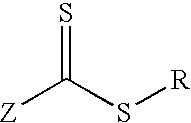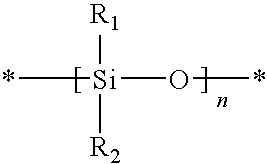Actinically-crosslinkable siloxane-containing copolymers
a technology of siloxane and copolymer, which is applied in the field of soft silicone hydrogel contact lenses, can solve the problems of mold size fluctuations, molds that cannot be uniformly shrinked, and molds that cannot be uniformly sized
- Summary
- Abstract
- Description
- Claims
- Application Information
AI Technical Summary
Benefits of technology
Problems solved by technology
Method used
Image
Examples
example 1
[0113]Oxygen permeability measurements. The oxygen permeability of a lens and oxygen transmissibility of a lens material is determined according to a technique similar to the one described in U.S. Pat. No. 5,760,100 and in an article by Winterton et al., (The Cornea: Transactions of the World Congress on the Cornea 111, H. D. Cavanagh Ed., Raven Press: New York 1988, pp 273-280), both of which are herein incorporated by reference in their entireties. Oxygen fluxes (J) are measured at 34° C. in a wet cell (i.e., gas streams are maintained at about 100% relative humidity) using a Dk1000 instrument (available from Applied Design and Development Co., Norcross, Ga.), or similar analytical instrument. An air stream, having a known percentage of oxygen (e.g., 21%), is passed across one side of the lens at a rate of about 10 to 20 cm3 / min., while a nitrogen stream is passed on the opposite side of the lens at a rate of about 10 to 20 cm3 / min. A sample is equilibrated in a test media (i.e., ...
example 2
General Scheme for Preparation of Prepolymers
[0120]The following scheme illustrates how to prepare a prepolymer of the invention.
example 3
Copolymer Synthesis
[0121]Polydimethylsiloxane-diacrylamide (PDMS-DAm MW 11.5K from Shin-Etsu) (37.5 g, 3.3 mmol) and n-propanol (252 g, AppliChem) are added to a 500 mL round bottom flask equipped with magnetic stirrer and nitrogen inlet. 2,2′-azobisisobutyronitrile (AIBN from Fluke, recrystalised) (0.026 g, 0.16 mmol,) and 4-thiobenzoylsulfanyl-4-cyanopentanoic acid (TCA from SyMO-Chem) (0.065 g, 0.23 mmol) as well as N,N-dimethylacrylamide (DMA from Bimax) (12.5 g, 126 mmol) and hydroxyethylacrylate (HEA from Aldrich) (12.5 g, 108 mmol) are added to the reaction flask under nitrogen flow. The mixture is cooled with an ethanol-bath, then degassed 4 times for 4 minutes at 5×10−2 mbar and allowed to warm up to ambient temperature. The reaction mixture is heated at 68° C. for 18 hours, during that time monitoring samples are withdrawn from the reaction flask. The reaction solvent is then exchanged against water, obtained copolymer is purified by means of diafiltration (membrane cut-of...
PUM
| Property | Measurement | Unit |
|---|---|---|
| Fraction | aaaaa | aaaaa |
| Percent by mass | aaaaa | aaaaa |
| Percent by mass | aaaaa | aaaaa |
Abstract
Description
Claims
Application Information
 Login to View More
Login to View More - R&D
- Intellectual Property
- Life Sciences
- Materials
- Tech Scout
- Unparalleled Data Quality
- Higher Quality Content
- 60% Fewer Hallucinations
Browse by: Latest US Patents, China's latest patents, Technical Efficacy Thesaurus, Application Domain, Technology Topic, Popular Technical Reports.
© 2025 PatSnap. All rights reserved.Legal|Privacy policy|Modern Slavery Act Transparency Statement|Sitemap|About US| Contact US: help@patsnap.com



